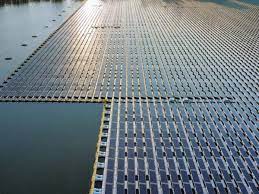Equatorial calm seas offer unlimited solar energy potential. Indonesia and West Africa could alone generate 35,000 TWh annually with offshore floating solar panels, aided by affordable engineering solutions.
Solar power rules by mid-century
By 2050, global decarbonization and electrification will rely on extensive solar and wind energy. 70 sq km of solar panels can power a million affluent individuals in a carbon-free economy, placed on rooftops, arid areas, or water bodies. High-population density countries like Nigeria and Indonesia can benefit from unlimited energy with floating solar panels in calm equatorial seas, while inland floating solar shows substantial potential and growth.
Calm Waters hold Massive solar potential
New research reveals calm ocean regions perfect for floating solar panels, requiring minimal engineering defenses. Such areas could generate up to one million TWh annually, five times the energy required for a decarbonized global economy supporting 10 billion affluent people. Prime sites near the Equator, Indonesia, and equatorial West Africa offer potential amid high population growth and environmental significance. Marine floating solar may alleviate land use conflicts, unlocking sustainable energy solutions.
Indonesia has vast solar energy potential
Indonesia, facing a potential population of over 315 million by mid-century, can leverage its dense yet vast landscape. With extensive solar and pumped hydro energy storage potential, around 25,000 sq km of solar panels could support a decarbonized, affluent Indonesia. Floating solar options on calm inland seas, covering 140,000 sq km of undisturbed seascape, offer a remarkable 200-fold surplus compared to the nation’s future offshore floating solar energy requirements across its 6.4 million sq km maritime area.
The future for offshore floating solar
Equatorial regions, like Indonesia and Gulf of Guinea near Nigeria, offer ideal sites for offshore floating solar panels with low storm risk, high population, and intact ecosystems. Despite challenges like corrosion and marine impact, these panels will play a major role in supplying solar energy to over a billion people in calm sea-accessible countries by mid-century, leading the energy revolution.

















